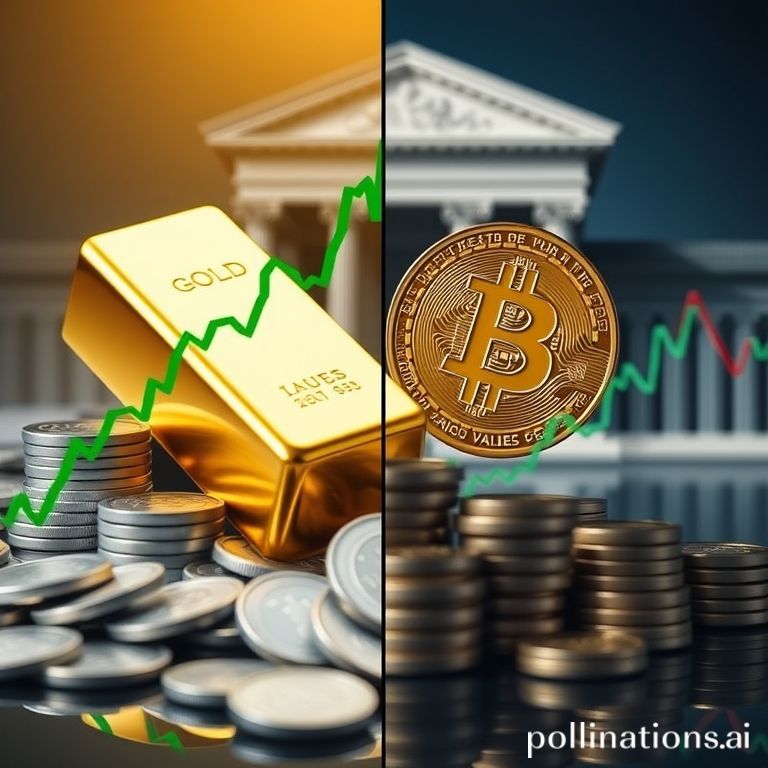
The Shifting Sands of Investment: Gold's Resurgence Amidst Bitcoin's Retreat
In the ever-evolving landscape of global finance, recent market movements have captured significant attention, particularly the contrasting performances of gold and Bitcoin. While the digital asset experienced a notable dip, the yellow metal staged an impressive rally, reaching new record highs. This divergence has sparked discussions among analysts, suggesting a potential "profit rotation" where investors might be shifting capital from the volatile crypto market towards more traditional safe-haven assets.
The Allure of Yellow Metal: Gold's Stellar Performance
Gold, long revered as an analog for sound money and a hedge against economic uncertainty, has demonstrated remarkable resilience and growth. On a recent Monday, the precious metal surged by 1%, setting yet another record high. This robust performance has propelled its price to $3,721, contributing to an astonishing 43% year-to-date gain in 2025. Such a strong showing underscores gold's enduring appeal, especially during periods of market volatility and shifting macroeconomic conditions.
Bitcoin's Momentary Setback and the Rotation Hypothesis
In stark contrast to gold's ascent, Bitcoin (BTC), often hailed by its proponents as a digital form of sound money, experienced a noticeable setback. The cryptocurrency posted a 24-hour drop of 3%, causing its price to fall to $112,000 and bringing its year-to-date gain down to 17%. What makes this dynamic particularly intriguing is the timing: gold's advance commenced approximately an hour after Bitcoin's decline. This synchronized, yet inverse, movement fuels the hypothesis that profits from recent Bitcoin liquidations may have rotated into gold, as investors seek to secure gains or reposition their portfolios towards assets perceived as more stable.
Historically, these two assets rarely move in perfect tandem. While there have been occasional periods where both gold and Bitcoin have risen or fallen simultaneously, often with a short lag, the current scenario exhibits a stronger, more pronounced divergence. This suggests a deliberate strategic shift in investment capital rather than a coincidental market fluctuation.
Beyond Gold: Silver Also Gleams
The appeal of precious metals isn't limited to gold alone. Silver, another industrial and investment metal, has also seen significant gains, further supporting the profit rotation narrative. On the same Monday, silver advanced by 1.5%, approaching the $44 mark. This represents its third-highest level since 1975 and contributes to an impressive year-to-date increase of over 50%. The collective strength of both gold and silver indicates a broader trend of capital flowing into the metals sector, reflecting a potential shift in investor preference.
Macroeconomic Currents: The Fed's Influence and Dollar's Strength
These market movements are not isolated events but are deeply intertwined with recent macroeconomic developments. Notably, since the Federal Reserve implemented a 25 basis point interest rate cut on September 17, there have been observable shifts across various asset classes. Both gold and the S&P 500, a key indicator for the broader equity market, have risen approximately 1% following the Fed's decision.
However, other indicators show a more complex picture. U.S. treasury yields have also risen, with the U.S. 10-year yield climbing to 4.125% (up 2.5%) and the U.S. 30-year yield reaching 4.7% (up 2%). This indicates evolving expectations regarding inflation or economic growth. Concurrently, the U.S. dollar strengthened, with the DXY index adding 1% to 97.5. A stronger dollar typically exerts pressure on risk assets, as it makes dollar-denominated investments more expensive for international buyers. This conventional dynamic appears to have influenced Bitcoin, which has dropped over 3.5% since the Fed’s announcement, aligning with the dollar's appreciation.
Concluding Thoughts: A Reassessment of Value in Volatile Times
The recent market activity presents a fascinating case study of investor behavior amidst complex financial conditions. The observed rotation of potential profits from Bitcoin into precious metals like gold and silver suggests a strategic re-evaluation of risk and value. This shift is likely driven by a desire for more traditional safe havens in an economic landscape characterized by fluctuating interest rates, a strengthening dollar, and evolving sentiments towards digital versus tangible assets. As global markets continue to navigate uncertainty, the appeal of precious metals as a hedge against volatility and inflation may continue to grow, prompting investors to reassess their portfolios and seek stability where they can find it.
